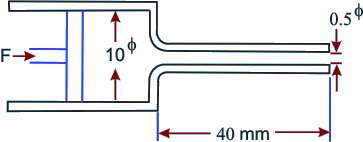|
Exercise Problems - Chapter 11
1. Calculate the force F required on the piston to discharge  of water through a syringe (see Fig. 37.4), taking into account the frictional loss in the syringe needle only. Assume fully developed laminar flow in the syringe needle. Take the dynamic viscosity of water of water through a syringe (see Fig. 37.4), taking into account the frictional loss in the syringe needle only. Assume fully developed laminar flow in the syringe needle. Take the dynamic viscosity of water  . .

Figure 37.4
2. A hydrocarbon oil (viscosity 0.025 pa-s and density 900 kg/m3 ) is transported using a 0.6 m diameter, 10 km long pipe. The maximum allowable pressure drop across the pipe length is 1 MPa. Due to a maintenance schedule on this pipeline, it is required to use a 0.4 m diameter, 10 km long pipe to pump the oil at the same volumetric flow rate as in the earlier case. Estimate the pressure drop for the 0.4 m diameter pipe. Assume both pipes to be hydrodynamically smooth and in the range of operating conditions, the Fanning friction factor is given by:

3. Two reservoirs 1 and 2 are connected as shown in the Fig 37.5 through a turbine T. Given the friction factor relation

for the connecting pipes, the turbine characteristics  of water [ Q in m3/s] and an ideal draft tube at the discharge end, find (a) the volume flow rate between the two reservoirs and (b) the power developed by the turbine. Note: of water [ Q in m3/s] and an ideal draft tube at the discharge end, find (a) the volume flow rate between the two reservoirs and (b) the power developed by the turbine. Note:




Use an initial guess for power developed by the turbine as 1 MW. Show only two iterations . Also H is head available at the turbine.

figure 37.5
To
view the recap, click next button or select from left-hand-side. |
|